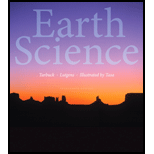
A brief summary of the events that led to the formation of the Earth by referring to the figure 12.4.
Answer to Problem 2GST
The steps that led to the formation of the Earth are,
- a) Big Bang occurred ago 13.8 billion years ago.
- b) Hydrogen and helium atoms created.
- c) Hydrogen and helium condensed and coalesced formed the first star system.
- d) Supernova explosions led the synthesis of heavy elements.
- e) The solar nebula started to contract 4.7 billion years ago.
- f) The materials collected in the center formed as a hot protosun.
- g) Accretion of planetesimals formed the Earth and other planets 4.6 billion years ago.
- h) The continuous bombardment and radioactive decay produced Magma Ocean.
- i) Chemical differentiation produces the Earth’s layered structure.
- j) Mars-sized asteroid impacted with the young Earth 4.5 billion years ago.
- k) Debris orbits earth and they accrete.
- l) Formation of earth-moon system.
- m) Outgassing produces the Earth’s early atmosphere and ocean.
Explanation of Solution
The universe and the Earth are formed by the occurrence of several events. The first major event is Big Bang; it is occurred about 13.8 billion years ago. The subatomic particles, including protons, neutrons, and electrons are the products of the Big Bang. Later the subatomic particles cooled and combined to produce the atoms of hydrogen and helium. These two simplest elements were condensed and coalesced to form the first star system.
Then the stars became aged and died after the continuous nuclear fusion reaction; these aged stars would explode and produce elements heavier than the iron. These types of cataclysmic events are called the supernova explosions.
Then the large rotating clouds of dust and gas containing solar nebula are formed after the massive supernova explosion. The clouds of dust and gas containing nebula contracted and became in flatten, rotating disk shaped rotating cloud. The materials collected in the center formed as a hot protosun. The repeated collision and accretion of remaining materials resulted in the formation of asteroid-sized objects called the planetesimals.
Over time, the repeated collision and accretion of planetesimals occurred, (the way in which planetesimals formed) this resulted in the gradual formation of eight planets.
During the Hadean, the continuous bombardment and decay of radioactive elements with heating produce Magma Ocean with several hundreds of kilometers deep took place.
Then the different stages of chemical differentiation were created along with the three divisions of the Earth’s layered structure. The impact of mars-sized object with the young Earth created an orbit of accreted materials around the Earth, and the accretion of the materials that orbiting the Earth lead to the formation of earth-moon system.
The water vapor and gases released by outgassing was responsible for the formation of the Earth’s early atmosphere and ocean.
Want to see more full solutions like this?
Chapter 12 Solutions
Earth Science (14th Edition)
 Applications and Investigations in Earth Science ...Earth ScienceISBN:9780134746241Author:Edward J. Tarbuck, Frederick K. Lutgens, Dennis G. TasaPublisher:PEARSON
Applications and Investigations in Earth Science ...Earth ScienceISBN:9780134746241Author:Edward J. Tarbuck, Frederick K. Lutgens, Dennis G. TasaPublisher:PEARSON Exercises for Weather & Climate (9th Edition)Earth ScienceISBN:9780134041360Author:Greg CarbonePublisher:PEARSON
Exercises for Weather & Climate (9th Edition)Earth ScienceISBN:9780134041360Author:Greg CarbonePublisher:PEARSON Environmental ScienceEarth ScienceISBN:9781260153125Author:William P Cunningham Prof., Mary Ann Cunningham ProfessorPublisher:McGraw-Hill Education
Environmental ScienceEarth ScienceISBN:9781260153125Author:William P Cunningham Prof., Mary Ann Cunningham ProfessorPublisher:McGraw-Hill Education Earth Science (15th Edition)Earth ScienceISBN:9780134543536Author:Edward J. Tarbuck, Frederick K. Lutgens, Dennis G. TasaPublisher:PEARSON
Earth Science (15th Edition)Earth ScienceISBN:9780134543536Author:Edward J. Tarbuck, Frederick K. Lutgens, Dennis G. TasaPublisher:PEARSON Environmental Science (MindTap Course List)Earth ScienceISBN:9781337569613Author:G. Tyler Miller, Scott SpoolmanPublisher:Cengage Learning
Environmental Science (MindTap Course List)Earth ScienceISBN:9781337569613Author:G. Tyler Miller, Scott SpoolmanPublisher:Cengage Learning Physical GeologyEarth ScienceISBN:9781259916823Author:Plummer, Charles C., CARLSON, Diane H., Hammersley, LisaPublisher:Mcgraw-hill Education,
Physical GeologyEarth ScienceISBN:9781259916823Author:Plummer, Charles C., CARLSON, Diane H., Hammersley, LisaPublisher:Mcgraw-hill Education,





